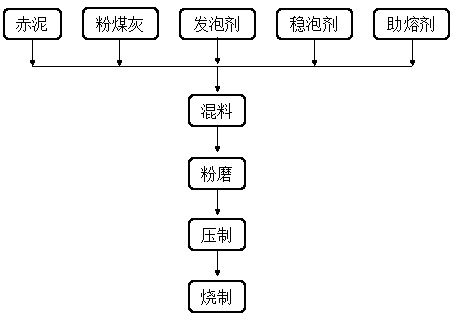Method for preparing foam microcrystalline glass through red mud
A foamed glass-ceramic and red mud technology, applied in the field of foamed glass-ceramic, can solve the problems of harming the environment and destroying cultivated land, and achieve the effects of low cost, promoting crystallization, and rich sources of raw materials
- Summary
- Abstract
- Description
- Claims
- Application Information
AI Technical Summary
Problems solved by technology
Method used
Image
Examples
Embodiment 1
[0035] A method for producing foamed glass-ceramics from red mud and the prepared foamed glass-ceramics, the ingredients are as follows:
[0036] In parts by weight, the composition and dosage of the foamed glass-ceramic batch (100 parts in total, the same below) are: red mud 10, fly ash 45, calcium carbonate 3, dolomite 3, trisodium phosphate 7. Borax 32. The experimental steps are:
[0037] 1) Mixing: According to the ratio of raw materials, weigh red mud, fly ash, calcium carbonate, dolomite, trisodium phosphate, borax, mix evenly, and the mixing time is 5-10 minutes;
[0038] 2) Grinding: put the uniformly mixed batch into a ball mill and grind for 2.5 hours;
[0039] 3) Compression: Put the ground batch material into the abrasive tool and press it into a cylindrical sample with a radius of 25mm and a thickness of 7mm;
[0040] 4) Firing: Put the pressed sample into a reaction furnace and keep it warm at 900°C for 30 minutes to prepare foamed glass-ceramics.
Embodiment 2
[0042] A method for producing foamed glass-ceramics from red mud and the prepared foamed glass-ceramics, the ingredients are as follows:
[0043] In parts by weight, the composition and dosage of the foamed glass-ceramic batch (100 parts in total, the same below) are: red mud 15, fly ash 45, calcium carbonate 3, dolomite 2, trisodium phosphate 3. Zinc oxide 2. Borax 30. The experimental steps are:
[0044] 1) Mixing: According to the ratio of raw materials, weigh red mud, fly ash, calcium carbonate, dolomite, trisodium phosphate, zinc oxide, borax, mix evenly, and the mixing time is 5 to 10 minutes;
[0045] 2) Grinding: put the uniformly mixed batch into a ball mill and grind for 2 hours;
[0046] 3) Compression: Put the ground batch material into the abrasive tool and press it into a cylindrical sample with a radius of 25mm and a thickness of 7mm;
[0047] 4) Firing: Put the pressed sample into a reaction furnace and keep it warm at 870°C for 25 minutes to prepare foamed ...
Embodiment 3
[0049] A method for producing foamed glass-ceramics from red mud and the prepared foamed glass-ceramics, the ingredients are as follows:
[0050] In parts by weight, the composition and dosage of the foamed glass-ceramic batch (100 parts in total, the same below) are: red mud 12, fly ash 45, sodium carbonate 3, carbon powder 2, zinc oxide 3 , Borax 35. The experimental steps are:
[0051] 1) Mixing: According to the ratio of raw materials, weigh red mud, fly ash, sodium carbonate, carbon powder, zinc oxide, borax, and mix evenly. The mixing time is 5 to 10 minutes;
[0052] 2) Grinding: put the uniformly mixed batch into a ball mill and grind for 3 hours;
[0053] 3) Compression: Put the ground batch material into the abrasive tool and press it into a cylindrical sample with a radius of 25mm and a thickness of 7mm;
[0054] 4) Firing: Put the pressed sample into a reaction furnace and keep it warm at 850°C for 20 minutes to prepare foamed glass-ceramics.
PUM
| Property | Measurement | Unit |
|---|---|---|
| size | aaaaa | aaaaa |
| size | aaaaa | aaaaa |
| flexural strength | aaaaa | aaaaa |
Abstract
Description
Claims
Application Information
 Login to View More
Login to View More - R&D
- Intellectual Property
- Life Sciences
- Materials
- Tech Scout
- Unparalleled Data Quality
- Higher Quality Content
- 60% Fewer Hallucinations
Browse by: Latest US Patents, China's latest patents, Technical Efficacy Thesaurus, Application Domain, Technology Topic, Popular Technical Reports.
© 2025 PatSnap. All rights reserved.Legal|Privacy policy|Modern Slavery Act Transparency Statement|Sitemap|About US| Contact US: help@patsnap.com

